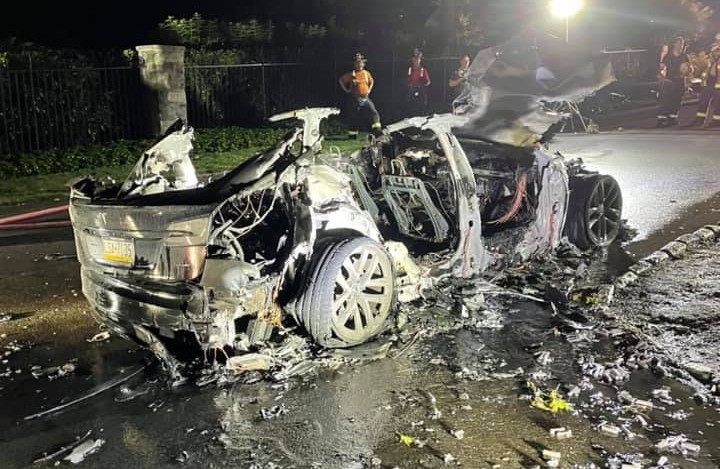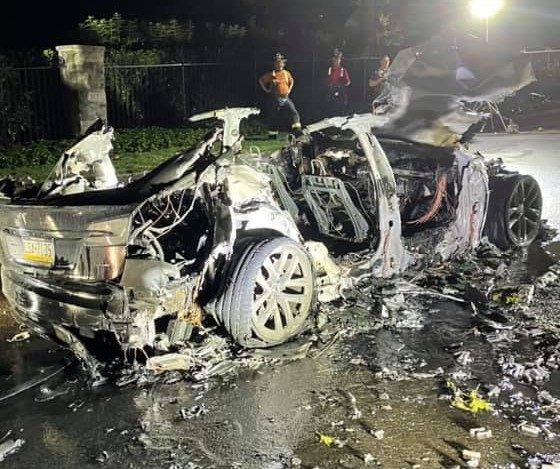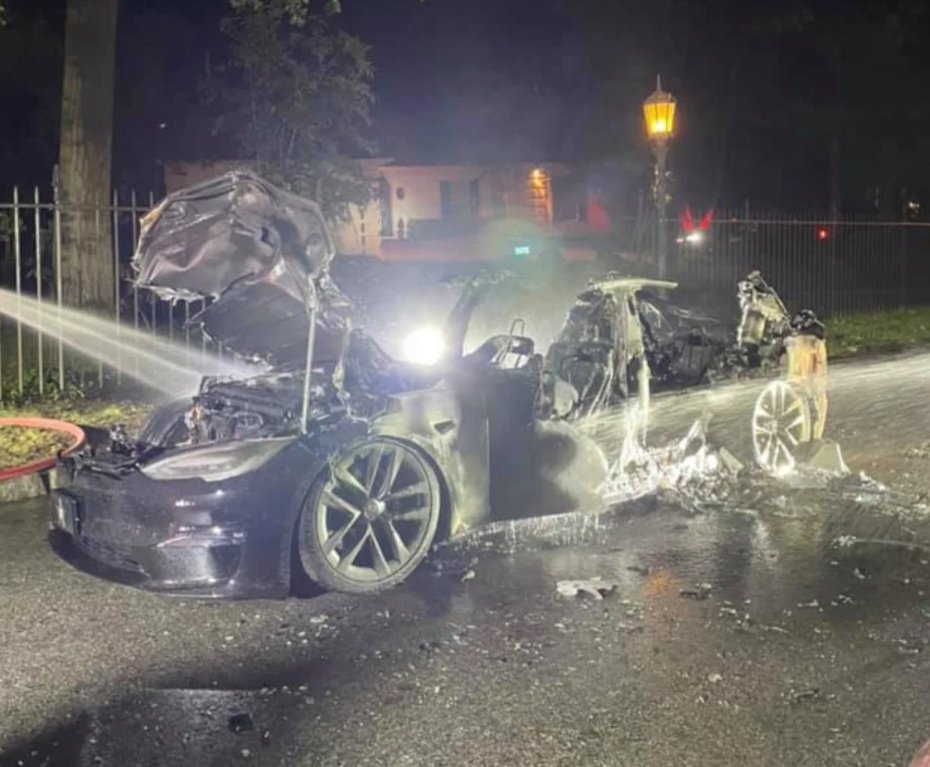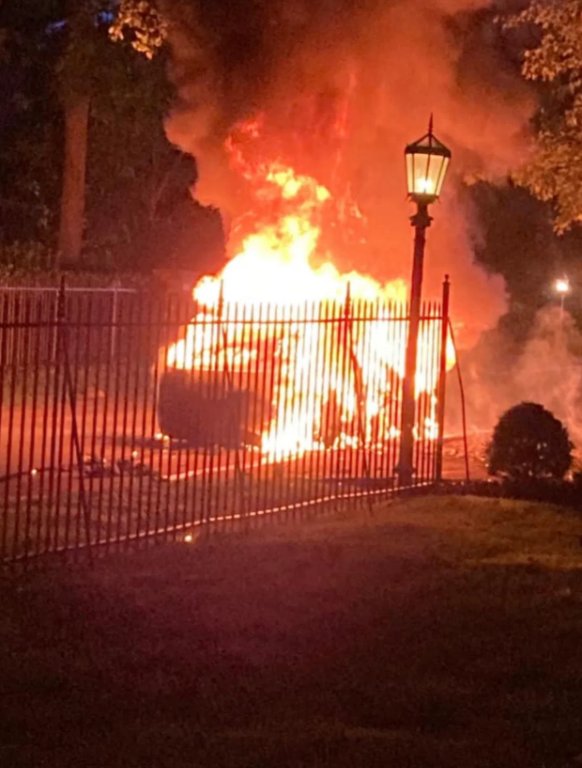

News
Tesla Model S Plaid fire: Strange observations and claims to date
Details about the Tesla Model S Plaid fire on Tuesday are starting to emerge. Similar to other dramatic electric vehicle fires, the details and observations emerging about the Tesla Model S Plaid fire are very interesting.
Accounts of the Model S Plaid fire have been shared by an EMT that reportedly responded to the incident, the chief fire officer for the Lower Merion Township Fire Department in Pennsylvania, and the lawyers representing the Model S Plaid owner.
With this in mind, it is pertinent to provide a view of what each party has stated about the incident so far. Going through each statement would potentially make it a lot easier to come up with a legitimate narrative in the future, especially as official investigations into the fire conclude. That being said, here are the accounts that have been shared on the Tesla Model S Plaid fire earlier this week.

What happened?
The Tesla Model S Plaid caught fire in Haverford, Pennsylvania on June 29, 2021. The vehicle, which was a Plaid variant based on the remains of its rear badge, was engulfed in flames when fire crews arrived. A Facebook post from the Gladwyne Volunteer Fire Company indicated that two fire engines were deployed for the incident. Firefighters were at the scene for about three hours, though the vehicle was cooled down for almost 90 minutes to ensure that the batteries were safe.
“Engine 24 with a crew of 7 arrived on scene simultaneously with Engine 25. Due to prior training classes on Tesla Vehicle Fire emergencies, Engine 24 laid a 5 inch supply line into the scene so that we could keep a continual water stream on the fire to extinguish the fire and cool the batteries down to ensure complete extinguishment. Engine 24 and Engine 25 both deployed hand lines to extinguish the fire, each maintained a dedicated water source and continued to cool the vehicle down for almost 90 minutes. Firefighters were on scene for just over 3 hours dealing with this emergency. Nobody was hurt in the incident, and both crews worked hard in the high heat/humidity to mitigate the incident,” the Gladwyne Volunteer Fire Company wrote.
Interestingly enough, this statement, as well as the Gladwyne Volunteer Fire Company’s Facebook post about the Model S Plaid fire has been taken offline. A look at the fire department’s Facebook page and its official website would reveal that the post about the Tesla fire has now been deleted.

A First Responder’s Account
As the story of the Model S Plaid fire gained ground, the incident started to attract a lot of attention on social media as well. On Reddit, u/wilyson, who claimed to be an EMT who responded to the fire, noted that the report they received about the incident was downright strange. According to the EMT, the person who reported the fire stated that the car was driving uphill without an occupant while it was ablaze. The owner was reportedly nowhere to be found. This was a rather dramatic image, and it promptly fueled speculations among the anti-EV crowd about “self-driving” cars catching fire.
Quite understandably, the EMT noted that he could not provide many details as the police are not releasing more information yet. That being said, the EMT later noted that car fires are very common and that electric vehicles are actually incredibly safe.
The Fire Chief’s Account
As noted in a CNBC report, chief fire officer for the Lower Merion Township Fire Department in Pennsylvania Charles McGarvey stated that the Tesla Model S caught fire on Tuesday while the driver was still at the wheel of the vehicle. According to the fire chief, firefighters eventually removed the Model S Plaid to a complex to safely store it overnight. The vehicle’s owner had since taken the remains of the vehicle from the facility, as per McGarvey, and will have the car investigated independently to determine the cause of the blaze.
The fire chief also stated that his teams had been in touch with Tesla and that some information about the incident should be made public soon. A National Highway Traffic Safety Administration spokesperson also noted that it was aware of the incident and that it is now in touch with relevant agencies and Tesla to gather more information about the fire. “If data or investigations show a defect or an inherent risk to safety exists, NHTSA will take action as appropriate to protect the public,” the NHTSA spokesperson said. The NTSB is not conducting an investigation to date.
The Lawyers’ Account
The Model S Plaid owner’s lawyers, Mark Geragos of Geragos & Geragos in Los Angeles, and Jason Setchen of Athlete Defender in Miami, have since mobilized to share details about the incident as well. In a statement to CNBC, the attorneys stated that the Tesla owner initially noticed smoke coming from the back of the Model S Plaid. Following this, the owner reportedly tried to unlock and open the vehicle’s doors, but he ended up having to force his way out of the car as the locks seemed to malfunction. The lawyers noted that after the Tesla owner left his car, the Model S began to move on its own while flames engulfed it.
Geragos Global attorney Ben Meiselas later posted a tweet sharing an image of the burning Model S. As per the lawyer, “Our firm & @AthleteDefender represent an exec who purchased new Tesla Plaid Model S, which was 1/250 shipped. On Tuesday it spontaneously combusted. Our client was trapped & could have died. We tried reaching out to Tesla & have been ignored so far. This is car after escape.”
Interesting (and strange) details
Overall, the Model S Plaid fire in PA features a number of interesting accounts that may not necessarily line up perfectly. The EMT that initially shared details about the incident mentioned that the Model S owner was nowhere to be found. The lawyers, on the other hand, shared an image reportedly taken immediately after the owner escaped, suggesting that the Tesla owner was on the scene of the blaze. As per the Model S Plaid’s Owner’s Manual, the vehicle is also equipped with a manual door release that should make it easy for occupants to vacate the car in case of an emergency. This seems to be a bit overlooked by the owner’s lawyers, who noted that their client was trapped inside the car.
Of course, the idea of a car driving on its own uphill while being engulfed in flames is quite strange, considering that neither Tesla’s Autopilot nor Full Self-Driving suite have such features. The only function that may have worked similarly is Smart Summon, but the vehicle was burning on a public street, an area where Smart Summon should have been unavailable.
We’ll definitely keep a pulse on this incident, as well as any details that may emerge as investigations go on, so do keep Teslarati on your radar as we follow developments in this event.
Do you have anything to share with the Teslarati Team? We’d love to hear from you, email us at tips@teslarati.com.

News
Tesla FSD fleet is nearing 7 billion total miles, including 2.5 billion city miles
As can be seen on Tesla’s official FSD webpage, vehicles equipped with the system have now navigated over 6.99 billion miles.

Tesla’s Full Self-Driving (Supervised) fleet is closing in on almost 7 billion total miles driven, as per data posted by the company on its official FSD webpage.
These figures hint at the massive scale of data fueling Tesla’s rapid FSD improvements, which have been quite notable as of late.
FSD mileage milestones
As can be seen on Tesla’s official FSD webpage, vehicles equipped with the system have now navigated over 6.99 billion miles. Tesla owner and avid FSD tester Whole Mars Catalog also shared a screenshot indicating that from the nearly 7 billion miles traveled by the FSD fleet, more than 2.5 billion miles were driven inside cities.
City miles are particularly valuable for complex urban scenarios like unprotected turns, pedestrian interactions, and traffic lights. This is also the difference-maker for FSD, as only complex solutions, such as Waymo’s self-driving taxis, operate similarly on inner-city streets. And even then, incidents such as the San Francisco blackouts have proven challenging for sensor-rich vehicles like Waymos.
Tesla’s data edge
Tesla has a number of advantages in the autonomous vehicle sector, one of which is the size of its fleet and the number of vehicles training FSD on real-world roads. Tesla’s nearly 7 billion FSD miles then allow the company to roll out updates that make its vehicles behave like they are being driven by experienced drivers, even if they are operating on their own.
So notable are Tesla’s improvements to FSD that NVIDIA Director of Robotics Jim Fan, after experiencing FSD v14, noted that the system is the first AI that passes what he described as a “Physical Turing Test.”
“Despite knowing exactly how robot learning works, I still find it magical watching the steering wheel turn by itself. First it feels surreal, next it becomes routine. Then, like the smartphone, taking it away actively hurts. This is how humanity gets rewired and glued to god-like technologies,” Fan wrote in a post on X.
News
Tesla starts showing how FSD will change lives in Europe
Local officials tested the system on narrow country roads and were impressed by FSD’s smooth, human-like driving, with some calling the service a game-changer for everyday life in areas that are far from urban centers.

Tesla has launched Europe’s first public shuttle service using Full Self-Driving (Supervised) in the rural Eifelkreis Bitburg-Prüm region of Germany, demonstrating how the technology can restore independence and mobility for people who struggle with limited transport options.
Local officials tested the system on narrow country roads and were impressed by FSD’s smooth, human-like driving, with some calling the service a game-changer for everyday life in areas that are far from urban centers.
Officials see real impact on rural residents
Arzfeld Mayor Johannes Kuhl and District Administrator Andreas Kruppert personally tested the Tesla shuttle service. This allowed them to see just how well FSD navigated winding lanes and rural roads confidently. Kruppert said, “Autonomous driving sounds like science fiction to many, but we simply see here that it works totally well in rural regions too.” Kuhl, for his part, also noted that FSD “feels like a very experienced driver.”
The pilot complements the area’s “Citizen Bus” program, which provides on-demand rides for elderly residents who can no longer drive themselves. Tesla Europe shared a video of a demonstration of the service, highlighting how FSD gives people their freedom back, even in places where public transport is not as prevalent.
What the Ministry for Economic Affairs and Transport says
Rhineland-Palatinate’s Minister Daniela Schmitt supported the project, praising the collaboration that made this “first of its kind in Europe” possible. As per the ministry, the rural rollout for the service shows FSD’s potential beyond major cities, and it delivers tangible benefits like grocery runs, doctor visits, and social connections for isolated residents.
“Reliable and flexible mobility is especially vital in rural areas. With the launch of a shuttle service using self-driving vehicles (FSD supervised) by Tesla in the Eifelkreis Bitburg-Prüm, an innovative pilot project is now getting underway that complements local community bus services. It is the first project of its kind in Europe.
“The result is a real gain for rural mobility: greater accessibility, more flexibility and tangible benefits for everyday life. A strong signal for innovation, cooperation and future-oriented mobility beyond urban centers,” the ministry wrote in a LinkedIn post.
News
Tesla China quietly posts Robotaxi-related job listing
Tesla China is currently seeking a Low Voltage Electrical Engineer to work on circuit board design for the company’s autonomous vehicles.

Tesla has posted a new job listing in Shanghai explicitly tied to its Robotaxi program, fueling speculation that the company is preparing to launch its dedicated autonomous ride-hailing service in China.
As noted in the listing, Tesla China is currently seeking a Low Voltage Electrical Engineer to work on circuit board design for the company’s autonomous vehicles.
Robotaxi-specific role
The listing, which was shared on social media platform X by industry watcher @tslaming, suggested that Tesla China is looking to fill the role urgently. The job listing itself specifically mentions that the person hired for the role will be working on the Low Voltage Hardware team, which would design the circuit boards that would serve as the nervous system of the Robotaxi.
Key tasks for the role, as indicated in the job listing, include collaboration with PCB layout, firmware, mechanical, program management, and validation teams, among other responsibilities. The role is based in Shanghai.
China Robotaxi launch
China represents a massive potential market for robotaxis, with its dense urban centers and supportive policies in select cities. Tesla has limited permission to roll out FSD in the country, though despite this, its vehicles have been hailed as among the best in the market when it comes to autonomous features. So far, at least, it appears that China supports Tesla’s FSD and Robotaxi rollout.
This was hinted at in November, when Tesla brought the Cybercab to the 8th China International Import Expo (CIIE) in Shanghai, marking the first time that the autonomous two-seater was brought to the Asia-Pacific region. The vehicle, despite not having a release date in China, received a significant amount of interest among the event’s attendees.








